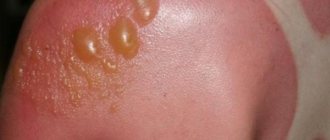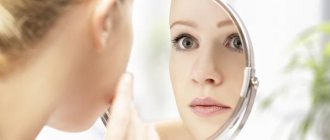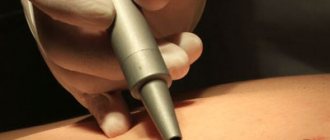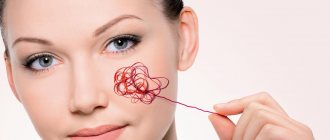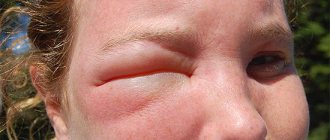Allergy to sea water
After sun or bathing, irritation and a rash appear on the child’s back, and often on the legs, arms, and chest (see photo).
Such symptoms may indicate that the child’s body reacts too sensitively to solar radiation or exposure to water. Similar phenomena occur in adults.
Fortunately, an allergic reaction to seawater is quite rare. Water contains many mineral components, which are often the culprits of rashes.
In addition, there is a lot of algae in the sea that can bloom and release allergens, there are also other representatives of the underwater world, all kinds of microorganisms. Industrial waste gets into the water.
The following symptoms indicate the disease:
- headache;
- a rash appeared;
- I'm worried about itching, my body itches.
Rashes on the body after the beach are more common in childhood; they can be all over the body or in separate areas.
Urticaria at sea (see photo) in most cases is complicated by severe itching, which creates additional discomfort for the victim.
The size of the blisters can reach quite impressive sizes. Their intensity and severity decreases over time.
Sometimes the body becomes hypersensitive when swimming in water due to relatively low temperatures. Hives appear on the body, the cause of which is hypothermia. This is also one of the types of disease - cold allergy.
Don't think that cold allergies only occur in winter. Often its symptoms appear while swimming in the summer. The allergen is not a substance, but a physical factor, so the disease is classified as pseudo-allergies.
Rash after swimming in the sea
Summer is a carefree, hot time, when many people gather on the banks of all kinds of bodies of water - rivers, lakes, quarries.
Cool water is refreshing and invigorating on a hot day, and relaxing by the river is a must for any summer vacation, but swimming in the river does not always end happily.
Sometimes after swimming a rash appears on the skin, which itches and causes discomfort. What to do if this happens to you?
First of all, you should understand the possible causes of the rash and itching. If the current in the river is not very strong, and you saw waterfowl on the coast where you stopped to rest, then the problem may be with them. So, the so-called swimmer's itch is a skin reaction to the larvae of helminths and trematodes. The more accurate scientific name for this disease is cercarial dermatitis.
Infection occurs as follows. Fluke larvae live in water and penetrate the skin of a person when he enters the river to swim. They cause irritation, redness of the skin and unpleasant itching.
The rash manifests itself in the form of urticaria, in other cases you may see papules on the skin. The most severe cases are the appearance of large blisters or large lumps on the skin that are very itchy.
In most cases, cercarial dermatitis goes away without a trace after seven days. The most unpleasant sensations and the greatest number of rashes are recorded on the second or third day after an unsuccessful bath.
In any case, if you suspect swimmer's itch, you should consult a doctor, especially if it occurs in a child. The doctor will make the correct diagnosis and, if necessary, prescribe medications.
It is worth noting that most often this disease is infected in stagnant bodies of water - ponds, lakes, but larvae can get into the skin and in rivers.
Another reason why your skin may develop a rash is a reaction to cold. It is clear that in the summer heat this sounds at least strange, but, nevertheless, our body can react in this way.
If you basked in the sun for a long time before swimming, and then suddenly went into cold water, then do not be surprised if, when leaving the river, you find traces of hives on your skin.
This is the so-called cold urticaria, which can appear on the skin with a temperature difference of only 5°C.
Most often, this reaction occurs in the southernmost regions and after swimming in the sea, but cold urticaria can also occur on hot days after swimming in the river.
If you don't want to get an itchy rash instead of the pleasure of swimming, stay a little in the shade before entering the river. Another recommendation - do not enter the water suddenly, it is better to cool down gradually, giving the body a chance to get used to the drop in temperature.
It is best to swim on hot days after seven o'clock in the evening, when the sun is no longer so hot.
Regardless of the cause of irritation, it is best to consult a doctor. If this is not possible or you plan to see a doctor the next day, then be sure to take antihistamines.
For example, suprastin helps relieve itching and inflammation. The dosage should be appropriate to the person’s age and weight. The doctor may also prescribe a 2% solution of salicylic alcohol.
It should be applied to a cotton pad and periodically wipe the areas where there are rashes.
If you still haven’t consulted a doctor, but after 3-5 days the rash bothers you more and more, it’s time to go to a dermatologist. He will either determine the cause and prescribe proper treatment, or give a referral to an allergist if it is an allergic reaction.
Treatment of swimmer's itch is carried out by reducing its manifestations. This disease cannot be cured; if you do not scratch the skin, it will go away after some time. Itching decreases a week after infection.
Symptoms
Sometimes dermatitis appears as small spots with a red dot in the center. Gradually they swell and blisters form. In this case there is:
The patient begins to scratch the affected and itchy area. What is not advisable to do, although the intensity of the itching is very high. When scratching, there is a high probability of infection, which can cause complications such as erysipelas.
The main symptoms also include:
- heat;
- dry cough;
- dizziness;
- insomnia.
Treatment
The most important treatment for this disease is patience. If you do not scratch the skin during the first week, then additional infection will not occur, which means that the symptoms will disappear.
In general, cercariae cannot live in or move around the human body. They die half an hour after being introduced into the skin. And dermatitis appears due to the pathogenic secretion injected by them.
After a week, the body begins to recover, the following is observed:
- reduction of papules;
- reduction of itching;
- maintaining light pigmentation for up to 3 weeks.
At the same time, when carrying out treatment, you should not pick off dried blisters. You cannot scratch them, as this will leave marks.
Treatment of this disease is carried out with medications, of which there are not so many. To relieve itching and inflammatory symptoms, you can use cooling lotions with cold water or using a soda solution. You can also apply to the skin:
- diphenhydramine-based ointment 5%;
- menthol ointment;
- anesthetic ointment.
Oral intake also helps treat dermatitis:
But the dose must be prescribed by the attending physician. It differs from the severity of the disease and the patient’s condition. To reduce the temperature that appears in the first days, antipyretics (aspirin, paracetamol) are used. For insomnia, you can ask your doctor to prescribe sleeping pills.
Source: https://www.PrishLek.ru/syp-posle-kupanija-v-more/
Reaction to the sun
Ultraviolet radiation can cause hypersensitivity in humans. Such processes are accompanied by rashes in the form of papules, vesicles, accompanied by the separation of serous exudate, thickening, roughness of the skin, pigmentation disturbances, and the appearance of grooves are observed.
In healthy people, as a rule, this is rare, mainly occurring in:
- infants;
- children with weakened immune systems;
- people with too light skin (Celtic type);
- old people;
- persons with pathologies of the liver, kidneys, as well as endocrine and immune systems.
There may be other types of immunopathological reactions, phototraumatic and phototoxic.
In the first case, it is sunburn. Probably everyone is familiar with how hot and sore the skin is after spending an excessive amount of time on the beach. Phototoxic burn also occurs as a result of exposure to sunlight. However, here the cause is drugs, foods or other substances that enter the body and produce a photosensitizing effect.
More often, people whose skin is too white or pale are susceptible to allergies. Traumatic effects occur very often.
In addition, photosensitizing substances (PS) often aggravate the situation even in people with normal skin type that is resistant to ultraviolet rays.
Many drugs contain VW in their composition, for example:
- group of tetracyclines (antibiotics);
- neuroleptics;
- sulfonamides;
- antifungals, for example, griseofulfin and some others;
- ethacridine lactate;
- oral contraceptives;
- tar.
Since the main purpose of these drugs is different, their photosensitizing effect is considered as a side effect. Another cause of photodermatosis can be contact with the skin of the juice of plants containing PV.
Sunburn may occur after direct contact with them. These plants include angelica officinalis, angelica silica and several species of hogweed.
Why do allergies appear after swimming?
- Causes
- Allergy after swimming photo
- Symptoms
- First aid
There is a well-founded opinion that no type of training and exercise has such a universal effect on the entire body as swimming.
It’s not for nothing that doctors prescribe swimming to their patients to combat a variety of diseases, both the musculoskeletal and cardiovascular systems.
However, unfortunately, not all people tolerate going to the pool well. Some people develop allergies after swimming, and therefore have to stop exercising. So what can an allergic reaction occur to after going to the pool and how exactly can it manifest itself? How should you act in such cases and is it possible to get rid of the problem?
Causes
In fact, there may be only a few possible causes for the problem, but the most common is individual intolerance to chlorine compounds (it is used to disinfect public swimming pools). It is this component contained in the water that in 9 out of 10 cases is associated with allergic manifestations that occur after visiting the pool.
It is noteworthy that chlorine itself is not an allergen, but when it gets on the mucous membranes and skin it interacts with some proteins in human hair, urine, skin or sweat.
These reactions produce various by-products, some of which may pose a risk to human health. These compounds, penetrating the body, make it vulnerable and overly sensitive to allergens.
As a result, a completely healthy person may become intolerant to dust, flowers, or even the hair of a beloved pet.
An allergy to the pool can appear after the first visit, but sometimes symptoms appear only after the tenth or fifteenth session. Everything is very individual.
The more (this means both the frequency of visiting the pool and the duration of sessions) a person visits the pool, the stronger his symptoms of the problem appear.
Allergy after swimming photo
Allergic manifestations to bleach occur not only from the skin, but also from the visual and respiratory systems. Therefore, it is necessary to consider each case separately.
The most severe manifestations of an allergy to bleach are, of course, associated with the respiratory system. Symptoms usually appear within a few hours after the end of the training process, in some cases the reaction occurs directly during swimming. Here are the main signs of respiratory problems that you should pay attention to:
Frequent visits to a public swimming pool by a person with a latent form of allergies can lead to the development of bronchial asthma and a number of other diseases of the respiratory system.
Allergies from the organs of vision also occur quite often, because the eyes are perhaps the most vulnerable target. Here are the main signs of pathology:
In rare cases, people experience eyelash loss. The reaction develops quite quickly, the first symptoms often appear 20-30 minutes after the start of the lesson and increase over time.
As a rule, at first there is a slight pain in the eyes, a desire to rub or scratch them. Subsequently, itching and constant burning are added, occurring with every blink.
Almost all people experience skin irritation after visiting a public pool sooner or later. It manifests itself differently in each person, some have a more pronounced reaction, some have less. Recognizing skin manifestations of allergies after visiting the pool is quite simple, here’s what you need to pay attention to:
Most often, symptoms arise rapidly, within the first few hours after contact with bleach, in rare cases after 12-14 days (this is basically how the allergic form of contact dermatitis develops, the progression of which can also trigger the development of dry eczema). In most cases, allergies are found in the groin and armpits.
Sometimes, with prolonged exposure to bleach on hair, there is increased fragility, dullness and hair loss.
First aid
It is impossible to get rid of the problem on your own, but it is very easy to relieve unwanted manifestations of allergies and provide first aid to yourself before going to an allergist. First of all, you need to avoid visiting the pool, as this will invariably lead to an increase in the symptoms of the disease.
If the reaction appears on the skin, then you need to take a shower and wash your entire body thoroughly with soap. Then the skin must be treated with some kind of softening cream (a simple baby cream or skin lotion will do, you can also use Bepanten). You can relieve itchy skin with chamomile baths.
Antihistamines are taken only in cases where allergy symptoms tend to constantly and rapidly increase. For this purpose, you can take Suprastin, Loratadine or Tavegil.
Source: //allergija.com/allergiya-posle-basseyna.html
Treatment and prevention of rashes
If a small red rash appears on your body while on vacation at sea, you should not immediately panic. First you need to try to find out the reasons for this phenomenon.
Such problems often arise among those tourists who do not know how to choose the right time to visit the beach. From 11 a.m. to 3 p.m., the intensity of ultraviolet radiation increases sharply, which causes allergies and other phototraumatic effects.
People with pale, sensitive skin need to be especially careful at this time, as their bodies do not produce enough melanin pigment, which helps neutralize the sun's rays.
They need to use tanning products. The protective cream cools the skin and protects it from sun rays, significantly weakening their influence.
The sea contains a lot of mineral salts, so it produces a drying effect. People with oily skin types experience a significant improvement in the condition of their skin after bathing.
But if your skin is already dry, it becomes more sensitive to everything and can easily become inflamed when exposed to very salty water.
As a rule, an allergic reaction develops, which causes the appearance of dermatitis, accompanied by severe itching.
To avoid this, it is advisable for people with sensitive skin to lubricate their body with a rich cream before each dive into water. After swimming, you should immediately dry yourself with a dry towel or take a shower with fresh water.
The measures taken will help avoid drying out the skin, since it is especially vulnerable on the beach - after all, it is affected by three elements at once: the sun, water and wind. The wind dries the skin, leaving a film of mineral salts on it after the water evaporates. This increases the burning effect of sunlight and causes immunopathological reactions.
What to do about sun allergies? Video:
Drug therapy
External agents (ointments, creams) with corticosteroids are very effective. But such treatment should only be prescribed by a doctor, since the drugs contain hormonal substances.
It is possible to use non-hormonal ointments and creams. These are Panthenol, Fenistil gel, Radevit, Losterin and others. Vinilin, Actovegin, and Psilo-balsam help well in the treatment of sunburn.
Doctors may prescribe antihistamines. Among them are Tavegil, Suprastin or Claritin, as well as some others. Of the newest antihistamines, they are very effective and do not cause side effects - Cetrin, Zodak, and so on.
Along with treatment, it is necessary to cleanse the body. As a rule, this is done with the help of enterosorbents (Enterosgel, Polysorb) and drinking plenty of fluids. Vitamin therapy is prescribed, since one of the causes of rashes may be a drop in immunity or a lack of vitamins in the body.
Rash on the body after sunbathing
Red rash after sunbathing
The small red rash that appears on the skin after sunbathing is in most cases photodermatitis, or an allergic reaction. Rashes can appear several hours and sometimes days after exposure to active sunlight. There is no specific treatment for this rash. If you are prone to sun allergies, it is recommended to take preventive measures, try not to be in the light for a long time during the day, and use special creams with a high level of protection from sun rays.
Allergy to sea and sun: provoking factors, symptoms, treatment
The desire of people to spend their holidays on the southern coasts may result in the unexpected development of photodermatosis associated with staying in other climatic conditions. Allergies to sea water or sun rays most often manifest themselves from the first days of staying at the resort. Red spots, papules or rashes form on the arms and legs, décolleté and thighs, and the irritation is unbearably itchy. To eliminate pathology, it is important to choose the right cosmetic and hygiene products, exclude photosensitizing products from the diet, and protect the skin from ultraviolet radiation.
Causes of dermatosis
A pathological reaction appears as a result of exposure to substances new to the body, which are perceived as foreign. In view of this, the production of antibodies (immunoglobulins E) begins with a parallel release of histamine, which leads to the formation of external signs of allergy. Many people associate inflammation and redness of the skin with exposure to ultraviolet radiation, but there are no substances in the sun's rays that can cause dermatosis.
The disease manifests itself after the interaction of light with particles localized on the surface of the epithelium (exogenous type) or in the inner layers of the dermis (endogenous type). As a result of chemical processes, skin sensitivity increases.
The appearance of a rash on the body after swimming in the sea indicates a possible allergic reaction to algae, mineral salts, microorganisms, and toxic substances from industrial waste.
Cold water causes hives. With this exposure, there are no symptoms of skin damage after the natural heating of the reservoir to the optimal temperature. In swimming pools, chlorine can be a causative agent of pathology. Dermatosis mainly manifests itself against the background of weakened immunity. At risk are:
- infants and young children;
- pregnant women;
- people with light skin.
The disease also progresses in patients with problems of the endocrine system, dysfunction of the kidneys, liver, and adrenal glands.
External factors that contribute to the development of sun allergies include the following:
- Cosmetic and sun protection products containing eosin, retinols, para-aminobenzoic acid, phenol, benzophenones. Additionally, you should avoid using perfumes, colognes, lotions, and hygiene products with fragrances. Essential oils of bergamot, tangerine, orange, rose, sandalwood, and sea buckthorn provoke increased exposure to ultraviolet radiation on the skin.
- UV irradiation sessions, tanning in a solarium, some cosmetic procedures (chemical peeling, tattooing of eyebrows and lips).
- Adding sweetener supplements to your diet, drinking citrus fruits, carrot juice, bell peppers, figs, celery, parsley or dill before going out into the sun. Skin sensitivity increases from drinking alcohol, spicy foods, foods with preservatives, dyes and artificial additives. There is a high probability of photodermatosis in allergy sufferers who are susceptible to nuts, chocolate, and coffee.
- Deficiency of vitamins and minerals.
Separately, we consider taking medications that can cause damage to the skin after sunbathing. Such a reaction of the body is possible even after the end of the course of therapy, since medicinal substances have a cumulative effect.
The group of provoking medications includes:
- Antibiotics, some antihistamines.
- Preparations for eliminating dermatological problems containing boric or salicylic acid, tar.
- Medicines for pathologies of the cardiovascular system, antidiabetic tablets, diuretics.
- Non-steroidal anti-inflammatory drugs.
- Oral (hormonal) contraceptives.
- Barbiturates, sulfonamides.
Side effects to medications usually include increased photosensitivity of the skin, so they should be used with caution.
Features of allergies
Irritation on the skin after swimming in the sea occurs quite rarely and, as a rule, intensifies when the dermis is exposed to ultraviolet rays. Rashes may appear on children's skin after prolonged swimming in sea water. This is due to the presence of blooming algae and numerous trace elements in it that can provoke the development of allergies.
A rash on the wet body of an adult is a reaction to sea salt. It manifests itself under the influence of sunlight. Redness is observed in the chest, back, neck, legs, and elbows.
Sea salt differs in composition from regular table salt and can cause severe allergies in both adults and children.
After a long swim in the sea, a large amount of sea salt and various microorganisms accumulate on the surface of the skin, the presence of which can be eliminated by taking a shower. In some cases, a negative reaction begins to manifest itself while a person is in the water. In this case, you should refuse swimming and urgently seek help from a highly qualified dermatologist .
Scuba diving enthusiasts notice rashes on the face, especially if the dive took place in a special mask. At first these are small (several millimeters in diameter) red spots. Without adequate timely treatment, the rashes grow to cover most of the back or chest, turning into ugly, scaly and crusty patches on the face.
Among the most likely causes of irritation are:
- lack of class “E” immunoglobulin in the body;
- bright skin;
- low immunity;
- presence of small wounds, sunburns;
- sudden climate change.
The spots that appear begin to itch very much. The main danger of this pathology is that when scratching, adults and children bring dirt into the wounds, provoking the development of an inflammatory process. Irritation of the skin after swimming in the sea can lead to the formation of papules filled with serous fluid. Violation of their shell leads to microtraumas that carry the risk of spreading infection.
A distinctive feature of this type of allergy is the absence of cough, rhinitis, and difficulty breathing.
Main features
Sun intolerance is often confused with other types of allergies. The pathology is characterized by the appearance in patients of a reaction to the sun and sea water immediately after exposure to ultraviolet radiation or swimming. Sometimes symptoms appear after 8-12 hours. At the same time, the general condition of the body changes: headaches, decreased muscle tone, and increased body temperature are noted. Photodermatosis affects the skin on the face, neck, shoulders, chest, thighs, arms and legs.
Due to imperfect immunity, children are often susceptible to developing the disease.
The photo below shows signs of an allergy in a child: patches of irritated skin, a profuse small rash. A feature of childhood ultraviolet intolerance is the high probability of “outgrowing” the pathology with age.
External signs of the disease in adults include:
- The appearance of red spots in areas of direct exposure to irritants.
- Swelling, abscesses of the affected area.
- Peeling, itching, burning of irritated epithelium.
- Formation of blisters with serous or purulent contents.
- Sometimes there is bleeding from erosions or inflamed blisters.
Some allergy sufferers may experience low blood pressure, fainting, or bronchospastic syndrome . Moreover, during the acute phase there is no coughing, sneezing, or tissue swelling. There is also virtually no risk of anaphylactic shock.
After sunbathing, a rash appears and itches
Rashes that appear on the skin after exposure to direct sunlight usually have the appearance of irritation, they can also look like a cluster of pustules, accompanied by swelling of the skin, burning and itching. Such rashes are mainly localized on the face, shoulders, back, arms and legs.
As a rule, the first sign of a rash is mild itching and discomfort in the affected area, followed by redness on the skin, which may increase in size. In different people, the manifestations of the reaction to the sun's rays can vary significantly: some have mild redness and a small rash, others have low blood pressure and significant areas of skin damage, and others may experience loss of consciousness.
People who suffer from eczema, porphyria or other skin diseases are most susceptible to developing a rash after sunbathing. Often, a person develops an allergy to the sun due to changes in the immune system.
Methods of treating the disease
After the first symptoms of an allergy appear on vacation, you should limit your exposure to the provoking factor. If a person reacts to salt water, it is necessary to choose coasts with less mineral content in the sea. In cases where skin damage occurs from contact with algae or plant pollen, it is worth considering the blooming period of allergens before planning a trip. Adjusting the diet, limiting the use of cosmetics and stopping medications also helps. To quickly remove toxins from the body, you need to drink 2-2.5 liters of clean water.
Drug therapy
In case of photodermatosis and sea allergies, consult a dermatologist, immunologist or therapist for the necessary advice. The doctor helps determine the cause of the pathological reaction and prescribes a treatment regimen.
Traditional therapy includes the following groups of drugs:
- Antihistamines. Due to the increased content of immunoglobulin E and histamine in the blood, special means are used to block them. Most often, medications are produced in tablet form (Suprastin, Cetrin, Claritin), but it is possible to apply external ointments or creams (Celestoderm, Psilo-Balm, Beloderm). The active substances eliminate itching well and can be used for a long time.
- Non-hormonal drugs for local treatment of lesions (Desitin, Panthenol, Fenistil-gel, Methyluracin ointment, Indomethacin).
- With the parallel development of inflammatory processes, it is possible to use drugs with antibiotics (“Levomekol”, “Tetracycline ointment”).
- Corticosteroids are prescribed only for severe disease. Long-term therapy with such products is not recommended, since the active ingredients can provoke the development of additional skin problems in the form of rosacea, erythema, and vasodilation. The danger lies in the rapid addiction to the drugs.
- To cleanse toxins and normalize liver function, take sorbents (“Enterosgel”, “Polysorb”, “Polifepam”).
- The deficiency of nutrients in the body is eliminated by consuming mineral complexes, antioxidants, vitamins B, E, C, and nicotinic acid.
Unconventional methods
Alternative medicine can help soothe inflamed skin.
- Thin slices of fresh cucumber and cabbage leaves applied to the rash areas relieve itching.
- Dried chamomile flowers and thyme herb are mixed in equal proportions. Place 100 g of dry raw materials in a thermos and add 1 liter of boiling water. After 10 hours, the reddened and itchy skin is treated with the prepared infusion. Treatment lasts at least a week.
- Thyme, chamomile, celandine in a ratio of 2:2:1 are crushed and poured with a liter of boiling water. Leave for 4-5 hours. The inflamed dermis is treated with the strained infusion 5-6 times a day. The effect will be noticeable after the first two days of use.
It is important to remember that the use of any medicinal compositions is possible only after consulting a dermatologist.
You've warmed up under the sun - you're tempted to swim in the pond. It is dirty and cold, but you can’t stand it and dive. And after a few minutes, the whole body is covered with pink bubbles. What is this - an allergy to water? Or something different?
Rash after swimming
“Most often, allergic urticaria manifests itself this way,” explained Anatoly Kolomiytsev, a dermatologist. - The main allergens in this case can be foods, plant pollen, and medications, and cold water only provokes an exacerbation of the disease. Therefore, people suffering from hay fever (seasonal summer allergies) should not swim in very cold water.
Urticaria can also be caused by ultraviolet radiation or overheating on the beach. And again, cold water only provokes the appearance of bubbles. They can also be a manifestation of contact urticaria (for example, due to touching plants that grow in a pond or sea, aquatic microorganisms, jellyfish, etc.). In this case, the rash is very hot, itchy, and sometimes even turns blue.
Allergy to the sea in adults and children
A trip to the sea can bring more than just joy. Often, a change in climate during a stay at a seaside resort causes deterioration in health. Not knowing whether there could be an allergy to the salty sea, people often associate skin rashes with an allergic reaction to products. In fact, a holiday at sea can cause allergies for many reasons:
- excessive insolation;
- mineralization of sea water;
- flowering of aquatic plants;
- isolation of marine microorganisms;
- jellyfish burn.
The appearance of hives can be caused by hypothermia.
- genetic predisposition;
- elderly age;
- pregnancy;
- endocrine diseases;
- liver and kidney diseases.
- weak immunity (small amount of immunoglobulin E in the blood).
People with fair skin are more likely to experience symptoms of photodermatosis due to low amounts of melanin pigment.
Is it possible to go to the sea if you are allergic?
Proper use of climatotherapy can improve the condition of an allergy sufferer. You need to travel for at least 21 days so that your body gets used to the new environment. Start sunbathing and swimming gradually, at intervals. The areas from Taman to Anapa on the Black Sea coast are the most favorable for child allergies. The temperate maritime climate improves immunity, normalizes metabolic processes, and calms the nervous system.
The main causes of sea allergies
Allergies to the sea can occur for many reasons: reactions to the chemical composition of water, the length of certain waves of the solar spectrum, to marine flora and fauna. Allergy attacks can be triggered by:
- cosmetics containing eosin, retinols, perfumes and essential oils;
- increased sensitivity to allergens is enhanced by spicy foods, citrus fruits, chocolate and alcoholic drinks;
- taking certain medications - tetracycline antibiotics, diuretics, non-steroidal anti-inflammatory drugs and other medications.
People prone to allergies should be careful during the first days of their stay at sea.
Reaction to cold water
Hives may appear when swimming in cold water (see “Allergy to cold” for more details). The body, heated in the sun, reacts to a sharp change in temperature with rashes on the skin. It is recommended to enter the water at t +20˚C and above.
Reaction to high salt levels
In different seas, water has its own mineral composition. The concentration of salts in the Dead Sea is so high that an allergy can occur in a person who has never suffered from it before. In the Black Sea, the water is also quite salty; its composition is similar to human blood plasma. Contains magnesium chloride and sulfate, calcium, 92 microelements (iodine, bromine, zinc). People with dry skin and young children are more likely to be hypersensitive to chemicals. The sun and wind further irritate the skin covered with salt.
Before bathing, the skin should be lubricated with a rich cream. After the sea, carefully dry yourself and your child with a soft towel, preferably take a shower.
Reaction to sea plants and algae
Contact with some aquatic plants and their decay products can cause a contact allergic reaction. People suffering from hay fever are allergic to algae blooms.
The flowering season of aquatic plants begins at the end of July and can last throughout August. For patients with hypersensitivity to pollen, it is better to visit resorts at other times of the year.
Allergy to jellyfish sting
Aurelia and cornerota are jellyfish whose sting causes allergies in the Azov and Black Seas. Jellyfish have stinging cells on the surface of their bodies, with the help of which they inject poison. An animal bite is accompanied by symptoms:
Negative reaction of the body to pollution and industrial waste
When on vacation, you need to carefully choose your swimming spots. Swimming in the sea near cargo ports, sewage treatment plants, and industrial enterprises is extremely unsafe. A variety of chemical compounds, including heavy metal salts, can come into contact with the skin. An allergic reaction in such cases is unpredictable.
Other reasons
An allergy to the sun's rays should be differentiated from a sunburn, which occurs when exposed to the sun for too long. Rash and skin irritation due to an allergic reaction occur even with a slight tan. Ultraviolet rays interact with the outer or inner layers of the dermis, increased sensitivity manifests itself as a result of internal processes in the body.
People who are allergic to dust may have a painful reaction to sand blown by the sea wind.
Aquagenic body itch - what is it?
Doctors use the term “aquagenic itch” to describe a feeling of widespread discomfort comparable to tingling of the skin. This unpleasant sensation is not accompanied by any changes in the skin, and its appearance is clearly associated with water procedures (exposure to water of different temperatures).
Most often, the problem of aquagenic itching begins to bother a person almost suddenly, perhaps even for no apparent reason. The intensity of unpleasant symptoms may increase over the years.
Why does it happen?
To date, the causes of skin itching after contact with water are not one hundred percent clear to doctors and scientists. Nevertheless, experts have come to the conclusion that the mechanism for the development of unpleasant sensations is clearly related to the production of certain substances in the skin that already cause itching. Just such elements include histamine, produced by mast cells. There is also evidence of a possible provoking role of acetylcholine. There is a theory that aquagenic itching can be provoked by various factors - physiological and pathological.
Physiological
The main causes of aquagenic itching are:
- Individual predisposition to some components of tap water, in particular, disinfectants added to it.
- Unfavorable skin perception of washing products that a person uses.
Pathological
Sometimes the appearance of aquagenic itching is just one of the symptoms indicating some serious health problems:
- Diabetes.
- Disturbances in the activity of the thyroid gland.
- Cholestasis.
- Polycythemia.
- Cancer.
- Dermatological diseases in the development stage (in particular, dermatitis or eczema).
- Helminthiases.
It is worth emphasizing, however, that identifying the causes of aquagenic itching often seems impossible. In such situations they speak of an idiopathic disease (without clear reasons for its development).
Differential diagnosis
When making an accurate diagnosis of “aquagenic itch,” doctors carry out a differential diagnosis with other diseases that are characterized by similar symptoms. Among these ailments:
- Cold urticaria. With this disease, the skin reacts to cold water, is very itchy and covered with typical blisters.
- Heat urticaria. The skin of this disease itches upon contact with warm water. They also develop blisters.
- Aquagenic urticaria. This disease is a type of allergic reaction and is also accompanied by skin changes - the appearance of blisters.
- Dermographism. With this type of urticaria, itching appears after intensive use of a washcloth or towel, accompanied by the formation of rubbing marks on the skin - inflamed swellings.
A typical sign of true aquagenic itching is the absence of any changes in the skin. The discomfort may last for several minutes or last for hours. Sometimes itching appears even before swimming.
What to do?
Of course, when faced with an incomprehensible itching of the skin, it is better not to self-medicate and seek medical help. If it is not possible to identify and correct the causes of unpleasant symptoms, doctors usually recommend:
- Limit the use of all kinds of cosmetics. It would be a good idea to switch to hypoallergenic products.
- Avoid jewelry, especially costume jewelry.
- Each time after water procedures, use oil or Vaseline to soften the skin. Hypoallergenic creams are also a good idea. Products containing phenol and menthol can somewhat reduce itching.
- Avoid long-term water procedures.
- Do not rub your skin with a towel after showering. You just need to blot it.
- Prevent scratching of the skin.
- Switch to clothes made from natural fabrics, but do not use wool in your wardrobe.
- Change your eating habits, give up frankly unhealthy foods, and also reduce your consumption of frankly allergenic foods. Doctors usually advise removing seafood, tomatoes, hard cheeses, coffee and tea, alcoholic beverages, as well as spices, bananas and pineapples from the menu. It is believed that such food can stimulate the synthesis of histamine in the body.
- Reduce your exposure to sunlight and avoid overheating.
Skin itching should not be ignored. Even if it appears for no apparent reason and goes away quite quickly, it may indicate the development of serious health problems.
Diagnosis of the disease
Often, only an allergist can identify the cause of an allergy. At the appointment, the doctor examines the patient and collects anamnesis.
In doubtful cases, skin tests are performed in the clinic (see “Skin tests for diagnosing allergies”). If sensitivity to sea salt is suspected, a water test is performed: a compress moistened with sea water is applied to the hand for 30 minutes. After 15 minutes, the result is assessed. The presence of hay fever is checked by nasal testing: a few drops of a control drug are instilled into the nose.
These studies involve certain risks. They are not given to children under 5 years of age, pregnant women, or the elderly. The presence of allergies in this group of patients is assessed by the amount of immunoglobulins E in the venous blood.
Treatment of allergies to the sea
What to do if you have an allergy to the sea? To improve the condition, you need to limit exposure to factors that cause increased sensitivity. If you are allergic to the salty sea, stop swimming; if you have photosensitivity, reduce the time spent in direct sunlight. Adjust the diet: exclude foods that contribute to allergies. To quickly remove toxins, drink 2-2.5 liters of clean water per day in small portions so as not to increase the load on the kidneys (see “How to cleanse the body of allergens and toxins if you have allergies?”).
Drug therapy
Drug therapy must be prescribed by a doctor, which is not always possible, especially when vacationing abroad. How to properly treat sea allergies? The main drugs used to relieve symptoms:
- Antihistamines - improve overall health. H1 histamine receptor blockers are effective - Suprastin, Claritin, Loratadine. Small children are given Fenistil drops.
- Sorbents - remove allergens and toxins from the body: Polysorb, Smecta, Enterosgel.
- Calcium gluconate - 1-2 tablets 3 times a day. Creates a protective barrier for allergens, reduces the permeability of blood vessels.
- Taking vitamins A, C, E improves immunity and speeds up recovery.
- To relieve irritation and itching, ointments are used - Beloderm, Celestoderm, Panthenol. For infection of erosions, use tetracycline ointment, Levomekol. Children are recommended to lubricate the affected areas of the skin with Isis and Skin-cap creams.
Hormonal ointments - Advantan, Akriderm - are used in extreme cases for rapid healing of the epidermis. Preparations with glucocorticosteroids should not be applied to the face and used for more than 5 days without a doctor’s prescription.
Traditional medicine tips
To quickly remove toxins and allergens from the body, do an enema with cold boiled water. You can use mild laxatives of plant origin: buckthorn bark, nettle leaf, yarrow herb (if you are not allergic to these plants).
Relief from inflammation of the skin, rashes, and blisters is brought by cool compresses with infusions of herbs: calendula, chamomile flowers, burdock root. Cool baths with the addition of healing infusions t 36-37˚C reduce itching and burning:
- 300 g of oatmeal is poured with boiling water and filtered. The infusion is added to baths to relieve irritation.
- 300 g of pine needles are steamed with 2 liters of water. Boil for half an hour, filter.
Reduces irritation of the epidermis by applying cabbage leaves, cucumber slices or raw potatoes to the skin. Freshly squeezed celery juice take 1 tbsp. l. 3 times a day as an antiallergic herbal remedy.
Skin manifestations of an allergy to jellyfish sting are treated with baking soda paste. Add 1 tbsp to the mixture. soda and 1 tbsp. l. fine salt add a little water. The paste is applied to the affected area and left until dry. Remove carefully without rinsing with water.
Prevention measures
Rules to help you avoid suffering from allergies at sea:
- sunbathe before 11 a.m. or after 3 p.m.;
- use creams with sunscreen filters SPF 30-50 depending on skin type;
- do not apply decorative cosmetics to the body;
- if you are allergic to salt water, relax at sea with a reduced concentration of minerals;
- the northern part of the Black Sea and the Sea of Azov are suitable for a child with allergies;
- gradually get used to sea water, maintain intervals between bathing (if there is a history of allergies);
- in case of hay fever, choose a time to rest when the water is not “blooming”;
- maintain water balance in the body, drink 2-2.5 liters of clean water per day;
- adhere to a diet that excludes coffee, chocolate, citrus fruits, and alcohol.
Families going on vacation should know what they may be allergic to while at sea. Parents vacationing with small children need to be careful and gradually accustom the baby’s body to new conditions. Avoid exposing the child to direct sunlight; if a rash occurs after bathing, stop water procedures.
source
Doctor's answer
Judging by the description of the symptoms and the mention of recent swimming in a pond, I can assume cercariasis, or schistosomatid dermatitis.
The eggs of these helminths fall into the water with the feces of birds, then develop to the cercaria stage in their intermediate host - some types of mollusks, after which the larvae again fall into the water, from where they penetrate human skin, where they die, since such an environment is unsuitable for their further life activity.
The introduction of larvae into the skin and their death are accompanied by an acute toxic-allergic reaction, the symptoms of which are:
- redness, swelling of the skin, the appearance of bubbles and blisters;
- severe itching;
- increased body temperature;
- sometimes nausea, cough, weakness, dizziness.
All manifestations usually disappear after one to two weeks. Each subsequent infection is more severe than the previous one.
To relieve itching, use:
- menthol-based creams and ointments (for example, Golden Star balm);
- diphenhydramine ointment;
- decoction of string;
- cool compresses with soda (a teaspoon per glass of water).
In severe cases of the disease, antihistamines and diphenhydramine are prescribed orally.
To avoid increasing the allergic reaction, it is necessary to exclude spicy and spicy foods from the diet, as well as potential allergens:
- citrus;
- strawberries, raspberries;
- chocolate and others.
Prevention measures may be the following:
- Avoid swimming in ponds overgrown with grass, where waterfowl live and accumulations of shellfish are observed.
- Do not walk barefoot on the coastal grass.
- Before bathing, lubricate your skin with oil or rich cream.
- After swimming, rinse with clean water and/or dry with a hard towel.
Of course, this assumption based on your brief description is just a diagnostic hypothesis. For an accurate diagnosis, I recommend contacting a dermatovenerologist.
Despite the fact that sea water has a wound-healing effect and can relieve a person of many skin pathologies, it is a fairly strong allergen and can cause a negative reaction in the body. Redness, large spots with blurred edges cover the face and body of a person, causing discomfort, causing itching, burning and dry skin.


